Updated on June 20, 2025 by Angelika
Most of Würzburg's sights can be easily reached on foot, as the city center is manageable. You can "walk" the highlights of the city center in one weekend.
For me, Würzburg is one of the most beautiful cities in southern Germany. Exceptional artists like the brilliant architect Balthasar Neumann and probably Germany's most famous sculptor and carver of the late Middle Ages, Tilman Riemenschneiderhave left numerous traces in churches and castles.
In addition to the artists, the city is proud of 14 Nobel Prize winnerswhose first Wilhelm Conrad Röntgen who discovered the groundbreaking X-rays in 1895
With 30,000 students in a population of 130,000, Würzburg is a very young city. Enjoy the good vibes at the Old Main Bridge, Four-Tube Fountain and the Mainauen!
Plan for two to three additional days to explore Würzburg's beautiful surroundingswhere you can discover many interesting places. You will find tips after the Top 10 sights of Würzburg.
The highlights of the city center are manageable in a one day walking tour - even if you don't have much time. I have put together my tips for a one-day tour of the most beautiful sights in Würzburg have been compiled for you under the table of contents.
💛 Support my travel blog
If you like my posts and appreciate my work, I would be delighted if you used one of my affiliate links for your next trip or order (these links are marked with an asterisk* in the post). The price remains the same for you - but I receive a small commission, which helps me to continue running this blog with heart and soul.
My partners for travel planning & inspiration:
→ Expedia - Hotels, flights & rental cars worldwide
→ Check24 - Compare rental cars cleverly
→ Amazon - Travel guides, travel accessories, photographic equipment, audio books and more
→ GetYourGuide - Guided tours, excursions & tickets for sights worldwide
→ We Travel The World - Germany travel guide with lots of insider tips
Thank you for reading and supporting me!
How to Explore Würzburg in one Day (with Map)
You can discover the sights of Würzburg's old town in one day.
I suggest that you start your tour of the city at the market square and not on the Marienberg fortress. There are several reasons for this: Firstly, I find it nicer to see the Brückenschoppen on the Old Bridge in the late afternoon or evening. On the other hand the view of the city from the Marienberg Fortress, in the mild afternoon or evening light is simply wonderful.
So let's start at the market square. With the tourist information you can stock up on information material and a city map. Since the tourist information is located in the Falcon House, you can already check off one of the main sights of the marketplace.
I recommend the tour of the old town in the following order:
A. Market square: Falcon House
Admire the magnificent rococo façade of the Falkenhaus and stock up on information about Würzburg at the Tourist Information Center (for more information, see 5. Marketplace and Lady Chapel).
B. Market square: Lady Chapel
Note the typical Würzburg Schwalbenlädlewho have settled on the outside of the Marienkapelle, the Tilman Riemendschneider's sandstone figures Adam and Eve at the south portal and the tympanum on the north portal (more information under 5. Marketplace and Lady Chapel).
C. Grafeneckart (Würzburg City Hall) and Four Tube Fountain
Through Langgasse you reach the oldest part of Würzburg's town hall, the Grafeneckart with the painted tree on the south façade, and the four-tube fountain in rococo style (more information at 6. Grafeneckart and Four-Tube Fountain).
D. Hof zum Wolfmannszichlein
From Grafeneckart, walk along Domstraße and Sterngasse to the courtyard of Wolfmannszichlein in Franziskanergasse 1A, where Tilman Riemenschneider's home and workshop were once located in today's Tilmans Prime Steakhaus restaurant (more information in the Info box about Tilman Riemenschneider.
E. Neumünster
Through Sterngasse, Plattnerstraße and Kürschnerhof you reach the Neumünster, which is one of the most important churches in Würzburg (for more information see 7. Neumünster).
F. Lusamgärtlein
In the Kreuzgarten of the Neumünster is the Lusamgärtlein with a memorial stone for the minstrel Walther von der Vogelweide (more information at 8. Lusamgärtlein (Lusam Garden)).
G. Cathedral St. Kilian
Martinstraße takes you to Kiliansplatz with St. Kilian's Cathedral, the fourth largest Romanesque church in Germany (more information at 8th Cathedral St. Kilian).
H. Würzburg Residence and Court Garden
To get to the residence (UNESCO World Heritage.), return to Martinstraße, which turns into Hofstraße. Follow this street to the end and then turn left into Balthasar-Neumann-Promenade, which will take you directly to the Residenz. If you have enough time, you should take a guided tour of the Residenz - it's worth it! But be sure to take a stroll through the magnificent Hofgarten (more information at 1. Residence Würzburg).
I. Old Bridge
After resting in the beautiful courtyard garden of the Residenz, you walk back through the city center to the Old Main Bridge. This will take you around 20 minutes - but there are also a few cafés along the way where you can take a break. At the Old Main Bridge, you should enjoy the beautiful views, admire the bridge saints and perhaps treat yourself to a Brückenschoppen. You can also save this as a reward for the way back from Marienberg Fortress to the city. You can find more information about the bridge at 3. Old Bridge "Alte Mainbrücke".
J. Marienberg Fortress
The path from the Old Main Bridge over the Tellsteige up to Marienberg Fortress offers very beautiful views. Stop every now and then to enjoy the view. Perhaps you can arrange it so that your tour of the fortress ends at the golden hour and you can admire the view of Würzburg and the Main from the fortress wall once again. You can find information about Marienberg Fortress at 2. Marienberg Fortress.
Sightseeing Würzburg: The Top 10 Must-See Places
1. Residence Würzburg
The Residence is Würzburg's most impressive landmark and has been listed as a 1981 to UNESCO–World Heritage. One of the most important baroque palace complexes in Europe was created in collaboration of famous artists and architects from different countries - and that more than 300 years before the foundation of the European Union!
The City Palace of the Würzburg Prince-Bishops was built between 1720 and 1744, but the interior design was only completed in 1780. Prince-Bishop Johann Philipp Franz von Schönborn appointed the young and then still unknown Balthasar Neumann as court architect for the new residence. A technical masterpiece and the most famous part of the residence is the column-free Staircase. The competent guides of the residence will explain the details to you.
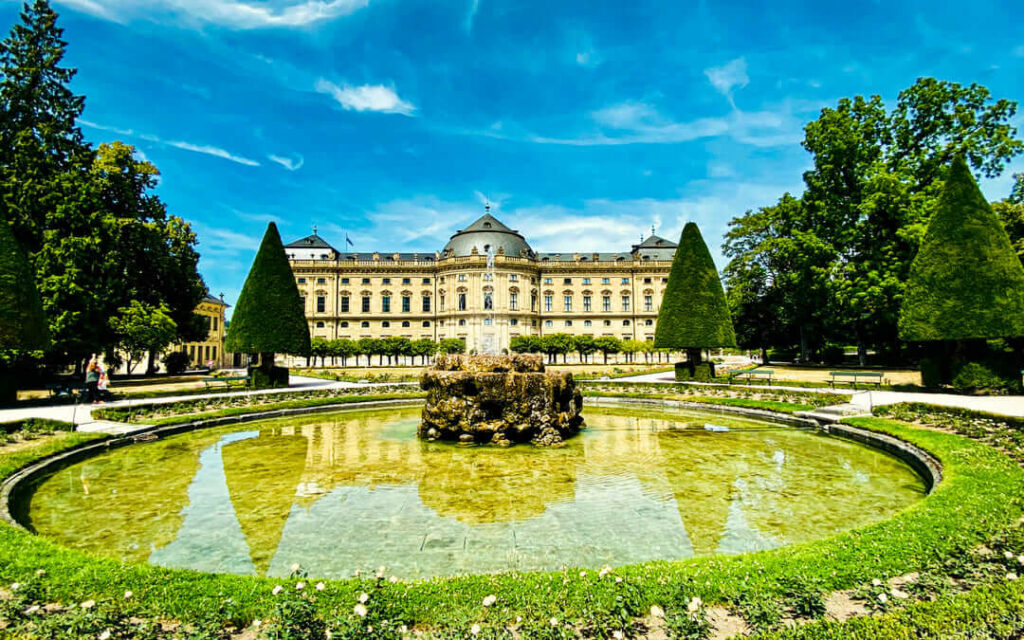
(with kind permission of the Bavarian Palace Department)
"Star architect" Balthasar Neumann
Balthasar Neumann (1687 - 1753) joined the military as a "commoner" in 1712. At that time, the career he aspired to as an engineer was only open to military personnel. In 1717/18 he was in Austria and Hungary with the Franconian troops. Presumably, he participated as an engineer in the Belgrade fortification during this time.
In Vienna he dealt with the style-defining baroque buildings of Johann Lucas von Hildebrandt and Johann Bernhard Fischer apart. In 1719, the new Würzburg Prince-Bishop Johann Philipp Franz von Schönborn appointed Neumann the prince-bishop's court architect for the new residence. Schönborn thus followed the recommendation of his uncle, the Elector of Mainz, Lothar Franz von Schönborn,who had already noticed Neumann's talent in 1715.
During a study trip in 1723 Neumann visited France, where in exchange with the great French master builder Robert de Cotte (architect of the king) and Germain Boffran he further developed his groundbreaking ideas for interior design. He later applied these to the construction of the Würzburg Residence and the staircase in Augustusburg Castle near Brühl (also a UNESCO World Heritage Site).
Staircase, Imperial Hall and Mirror Cabinet
The monumental ceiling fresco in the staircase was created by Venetian painter Giovanni Battista Tiepolo who was already world famous at that time, in an incredibly short period from 1752 to 1753. With 19 m x 32 m it is the largest continuous ceiling fresco in the world. You can easily recognize the then known four continents: Africa, Asia, America and Europe. If you join a guided tour of the residence , you will learn a lot of interesting facts about the history of the creation of the fresco.
In addition to the staircase, the representative Imperial Hall is a highlight of the residence. 20 half-columns of reddish stucco marble support the large oval dome. The three ceiling frescoes by Tiepolo thematize the history of Würzburg at the time of Emperor Friedrich Barbarossa, who in 1168 granted the bishop the ducal dignity and with it secular power.
Another masterpiece of the residence is the Mirror Cabinet, which was completely destroyed in 1945. Masters of their trade reconstructed it between 1979 and 1987 using the old reverse glass painting techniques. The Mirror Cabinet completed the reconstruction of the residence 40 years after the end of the Second World War.
You can find out more about the damages to the Residence during the Second World War in the Memorial Room, and about the reconstruction in the documentation room of the Würzburg Residence.
Bombing Raid on Würzburg on March 16, 1945
The Residence was severely damaged during the Royal Air Force bombing raid on Würzburg. However, the staircase and some halls of the central building remained, but the roofs were destroyed. After the end of the war, a department "Fine Arts and Monuments" was established in the military government for Lower Franconia, managed by John Davis Skilton.
Skilton was an art historian, and therefore was aware of the importance of the prince-bishop's residence and its unique interiors. He arranged for an immediate cover with tarpaulins and then for the erection of a provisional roof within half a year.
The reconstruction was only completed with the reconstruction of the mirror cabinet in 1987 and cost around 20 million euros. For his services to the Würzburg art treasures, Skilton received the Federal Cross of Merit 1st class in 1976. He remained closely connected to the city of Würzburg until his death in 1992.
Court Church "Most Holy Trinity"
The magnificent court church belongs to the residence and was also designed by Balthasar Neumann The entrance to the church is a bit hidden. If you stand in front of the residence, you will find it on the right in the south wing of the building.
The Court Church is a sight in itself and is considered a prime example of Baroque architecture. The Austrian Lucas von Hildebrandt opulently decorated it with stucco, frescoes and statues in marble and gold. The two paintings above the side altars were, like the famous frescoes in the staircase and the imperial hall of the Residence, painted by the Venetian Giovanni Battista Tiepolo.
If you still have energy, you can visit the picture gallery and antique collection in Martin von Wagner Museum in the south wing of the residence.

(with kind permission of the Bavarian Palace Department)
You can digest the many new impressions during a walk in the beautiful Court Garden,which you enter through the magnificent rococo gate next to the Court Church. Here you will find a shady place on a bench in one of the arcades even on a hot summer day.
A real feast for the eyes is the south garden at the back of the residence with the stone figure groups by Johann Peter Wagner, the rock fountain and the cone-shaped cut yews.
Würzburg Residence Info
Address: Residenzplatz 2, 97070 Würzburg
Opening hours: April - October daily 9 am - 6 pm, November - March daily 10 am - 4:30 pm.
Admission: Regular €10, reduced €9; the Hofkirche and Hofgarten are freely accessible.
Recommendation: It is worth taking part in the very informative guided tour (in German every full and half hour; in English daily at 11 am and 3 pm).
For further information, see Website of the residence.
2. Marienberg Fortress

(with kind permission of the Bavarian Palace Department)
Another important sight in Würzburg is the Marienberg Fortress. During the walk up to the fortress, you first cross the Old Bridge, to then continue up the Tellsteige to the castle.
The outdoor premises of the fortress are freely accessible at all times. Take your time to enjoy the magnificent panorama of the River Main and the old town, the pilgrimage church Käppele and the Würzburg vineyards.
From the 12th century the Prince Bishops used the mighty castle as their permanent residence, and had it expanded in the late Middle Ages. After the fortress had been stormed by the Swedes during the Thirty Years' War, Prince Bishop Johann Philipp von Schönborn initiated the construction of the bastions. At the Bombing of Würzburg by the Royal Air Force on March 16, 1945, the castle almost completely burnt down. The reconstruction was only finished in 1990.
The "Golden Freedom" of the Prince-Bishops
On the Imperial Diet in Würzburg 1168 Emperor Frederick I Barbarossa awarded the bishop Herold of Würzburg the so-called "Güldene Freiheit" (Golden Freedom), which granted the bishop ducal rights. Thus, the Prince bishop was recognized as the secular ruler of Mainfranken.
The merger of the offices gave the prince-bishops incredible wealth. The increasing discontent of the subjects - primarily peasants - culminated in 1525 in the German Peasants' War, in which more than 10,000 peasants and citizens of Würzburg lost their lives. The office of the prince bishop disappeared with the breakup of the Holy Roman Empire of the German Nation in 1806.
Today the fortress houses the Museum for Franconia with an extensive collection on Franconian art and cultural history. Among other things, it contains the world's largest collection of sculptures by Tilman Riemenschneider, who lived in Würzburg from 1483 until his death in 1531.
Marienberg Fortress Info
Address: Marienberg Fortress, 97070 Würzburg
Opening hours: The beautiful grounds, courtyards and defensive walls are freely accessible from Tuesday to Sunday (April-October: 9 am - 6 pm, November-March: 10 am - 4.30 pm). Public guided tours are also offered regularly. All information on opening times and guided tours can be found here.
Museum of Franconia: Opening hours April 1-October 31, Tuesday through Sunday 10 a.m.-5 p.m., November 1-March 31, Tuesday through Sunday 10 a.m.-4 p.m.; closed Mondays. Admission: 5 €, reduced 4 €. More information at Museum for Franconia
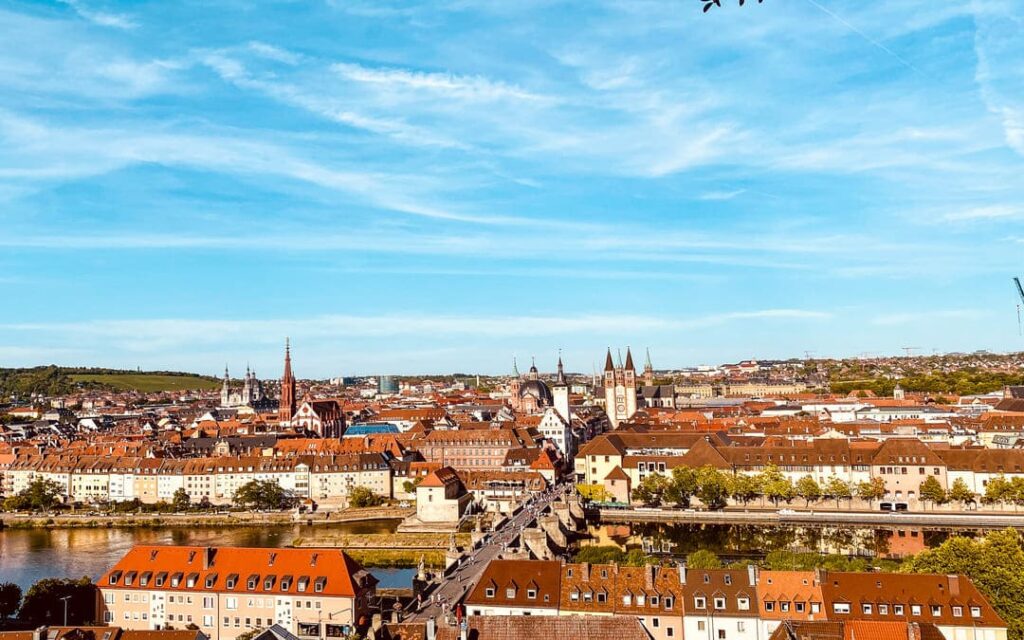
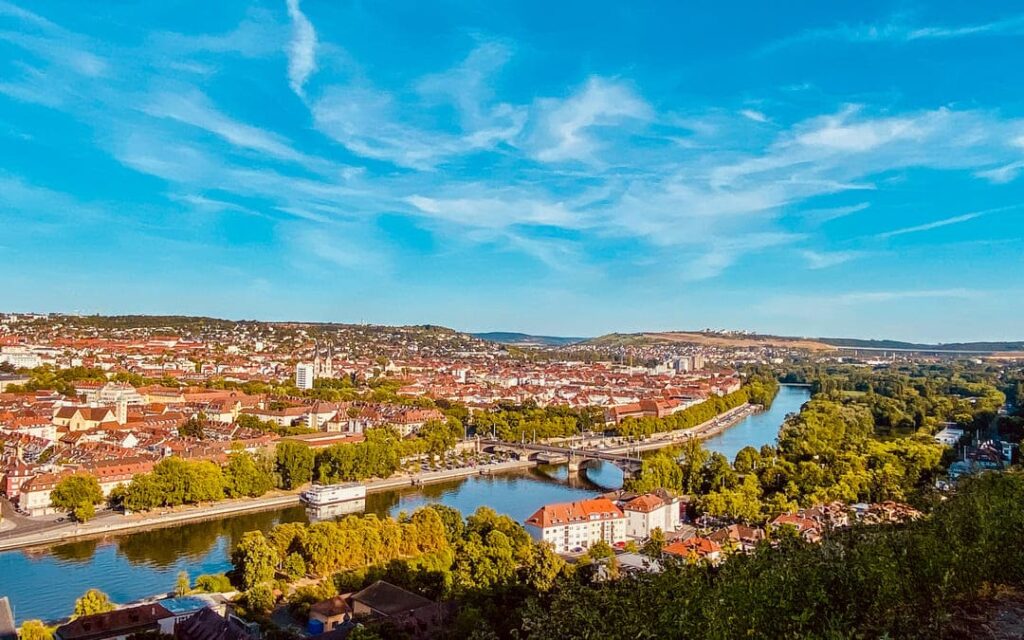
3. Old Bridge "Alte Mainbrücke"

The Würzburg sight that you practically can't miss is the Old Bridge. It is a visitor magnet, and probably your way will lead you there directly after arrival.
At the foot of the Old Main Bridge you can enjoy the traditional Brückenschoppen A Schoppen glass holds ¼ liter of Franconian wine. You pay a deposit and may take the glass to the bridge with you.
The Views from the Old Main Bridge over the Main River, Würzburg's Old Town and Marienberg Fortress is magnificent, and the bridge itself is absolutely worth seeing. Twelve stone figures of people who played a role in Würzburg's history adorn the structure. These so-called "Bridge Saints" include Charlemagne and the three Irish missionaries Kilian, Kolonat and Totnan.
When the river became more and more of a problem for the increasing trade in the 12th century, the cathedral and city architect Enzelin built a first, Romanesque stone bridge. Some parts of today's bridge are still from the original structure. From the end of the 15th century, individual piers had to be renewed because floods repeatedly damaged the structure.
The 12 baroque figures were erected around 1730. On April 2, 1945, German troops blew up the fourth and fifth bridge arches. Reconstruction was completed in 1950. The Old Bridge has been closed to motorized traffic since 1990.
Three Bridges that Look Similar
Model for the Old Bridge and also the Charles Bridge in Prague should be the Angel bridge in Rome which was already built under Emperor Hadrian and consecrated in 134 AD. However, the installation of the angel sculptures took place only in the 17th century under Pope Clement IX.
The Charles Bridge in Prague was built in the 14th century and was named after Emperor Charles IV only in 1870. It was used as part of the coronation route of the Czech kings and belongs to the National Cultural Monuments of the Czech Republic.
4. Cathedral St. Kilian

Würzburg Cathedral - the fourth largest Romanesque church in Germany - has been dedicated to St. Kilian since 1967 and is definitely one of Würzburg's most important sights. It was built from 1040 to 1237, after the two previous buildings had been completely or partially destroyed by fire. The Italian Pietro Magni created the baroque stucco work in the interior between 1701 and 1704.
Balthasar Neumann added the baroque Schönborn Chapel, the burial place of the prince-bishops, in the second half of the 18th century. The tombs of bishops Rudolf von Scherenberg and Lorenz von Bibra were made by Tilman Riemenschneider. Riemenschneider's tomb slab was only discovered in the cathedral's courtyard in 1822, when the cemetery was dissolved. A cast of it has been placed on the north outer wall of the cathedral. You can see the original in the Museum for Franconia in the Marienberg Fortress.
Tilman Riemenschneider -
Church Artist, Mayor and Rebel
Tilman Riemenschneider, born 1460, began an apprenticeship in 1474 in his hometown of Osterode in the Harz Mountains as a stone sculptor and wood carver. From 1478 he went on the road as a journeyman, and was recorded as a painter servant in the Würzburg Guild of Painters and Sculptors in 1483. When he married Anna Schmidt, a goldsmith's widow, in 1485, he received the Würzburg citizenship and master dignity. Thus, he fulfilled the requirements for the establishment of his own workshop.
His wife brought the property Hof zum Wolfmannszichlein at Franziskanergasse 1 (today the building houses the restaurant "Tilman's Steakhouse") into the marriage. Riemenschneider lived and worked here until his death in 1531. From the beginning, Riemenschneider's works received much appreciation. His workshop, where he employed up to 18 journeymen, supplied all of Franconia with his works. These were mainly commissioned works of religious content for the churches of the region. Riemenschneider's sculptures are characterized by expressive faces and detailed .
Also politically active. In 1504, he was elected to the city council and rose to the position of mayor. During the German Peasants' War of 1525 he stood together with other city councillors on the side of the rebels against the sovereign, Prince-Bishop Konrad II of Thüngen. Riemenschneider and other leaders of the uprising were arrested after the defeat on June 4, 1525, and imprisoned and tortured on the Marienberg Fortress. imprisoned and tortured. It was not until eight weeks after his imprisonment that Riemenschneider was released against payment of half of its assets The vindictive prince-bishop deprived him of all offices and honors and ensured that he didn't receive a major order until his death in 1531. Only the discovery of his grave slab on the Domleichhof (the cathedral's graveyard) set in motion a Riemenschneider Renaissance that continues to this day.
The cathedral was severely damaged at the air raid on Würzburg on March 16, 1945, and large parts collapsed in February 1946. The reconstruction lasted until 1967 and was based on the original Romanesque architectural style. Since the reconstruction in 1988, the choir room combines baroque and modern forms.
Cathedral St. Kilian info
Address: Domstrasse 40, 97070 Würzburg
Opening hours: Monday to Saturday 10 a.m. to 5 p.m., Sunday and holiday 1 p.m. to 6 p.m.
Cathedral tours: Monday through Saturday at 12:30 p.m., Sundays and holidays 2 p.m.; for more info, see here.
5. Marketplace and Lady Chapel

Another highlight of Würzburg is the market square with the Marienkapelle (Lady Chapel) and the magnificent baroque Falkenhaus (Falcon House), which houses the tourist information office.
The Lady Chapel on the north side of the market square dates from the 14th century and is considered a masterpiece of late Gothic architecture. Despite its size, it is "only" a chapel, as it was not endowed with parochial rights.
Before the construction of the Lady Chapel, there was a synagogue on this site, which was destroyed in a progrom against the Jewish population of Würzburg in 1349.
Progrom on the Jews of Würzburg in 1349
A rumor spread in the plague year of 1349 blamed the Jews for the outbreak of the plague. On April 21, 1349, hundreds of Würzburg Jews were murdered and their houses and synagogue burned down. Churches were also built in other Bavarian cities (Nuremberg, Munich, Landshut, Bamberg and Passau) where synagogues had previously stood. The foundation stone for the present Lady Chapel was laid by Bishop Gerhard von Schwarzburg on May 16, 1377, and was financed by donations of money and goods from the citizens of Würzburg (who were involved in the progrom).
You can find more interesting information about Jewish life in Bavaria and progroms in the Middle Ages in a highly interesting article on the website of the Bayerischer Rundfunk (Bavarian Radio).
The city council commissioned 1490 Tilman Riemenschneider, to make the sandstone figures of Adam and Eve for the south portal. The originals were replaced by copies during the 2nd World War and are now in the Museum for Franconia on the Marienberg Fortress,.
The tympanum on the north portalthat depicts Mary's proclamation will certainly amuse you: A twisted hose leads from God's mouth to Mary's left ear. The dove at the end of the hose symbolizes the Holy Spirit. On the hose, baby Jesus slides belly-down to Mary's ear. This would finally solve the mystery of the Immaculate Conception!

The Lady Chapel was badly damaged during the bombing raid on Würzburg in 1945. Numerous works of art were lost. The reconstruction took place from 1948 to 1961.
Inside the Lady Chapel there is the tomb of the knight Konrad von Schaumberg, made by Riemenschneider. Also Balthasar Neumann, the architect of the is one of the most beautiful and traditional Christmas markets in Bavaria and delights its visitors with a festive atmosphere against the impressive backdrop of the Falkenhaus and the Gothic St. Mary's Chapel (Marienkapelle). More than 100 lovingly decorated stalls shine in the city's historic market square during the Advent season, offering a wide range of handcrafted products, Christmas decorations and regional delicacies. The Würzburg Christmas market is particularly famous for its handmade nativity figures and traditional wooden toys, which are made in the region., , found his final resting place here.
Other Würzburg Sights on the Market Square: "Schwalbenlädle", Stand-Up Café and Falcon House
The small stores on the south and west sides of the Marienkapelle (Lady Chapel) are a special feature of Würzburg. As early as 1437, the church rented out these so-called "Schwalbenlädle" (literally "swallow stores"), which stick to the church like swallows' nests, to merchants. Würzburg's smallest café is also located here, Brandstetter's stand-up café (a branch of the long-established Würzburg bakery and confectionery Brandstetter).
The tourist information is located in the most magnificent house on the market square. The House to the Falcon, also called Falcon House, originally was the residence of the cathedral priest. In 1735, the innkeeper Franz Thomas Meißner bought the house and ran it as the inn "Zum Falken". After Meißner's death, his enterprising widow ran the inn and had the three-gabled, richly stuccoed rococo facade built in 1751. The house burned down during the bombing raid on Würzburg in 1945. It was reconstructed in the early 1950s based on old photographs.
Lady Chapel and Falcon House Info
Address Lady Chapel: Marktplatz 7, 97070 Würzburg
Opening hours: Open during the day
Admission: free
Detailed information at the Lady Chapel (Marienkapelle),.
Address Falcon House/Tourist Information: Marketplace 9,97070 Würzburg
Opening hours: Mon - Fri 10 a.m. to 6 p.m., Sat/Sun and holidays 10 a.m. to 2 p.m.
For further information, see the Tourist Information website.
6. Grafeneckart and Four-Tube Fountain
The Grafeneckart is one of Würzburg's top sights and is the oldest part of the Würzburg City Hall.
The Council of Citizenship, which was designated to counterbalance the Prince Bishop in Würzburg in the High Middle Ages, bought the Romanesque family tower together with the so-called Grünbaum (the side wing attached to the tower) near the Old Bridge in 1316. The unusual designation Grafeneckart commemorates the bishop's mayor and Vizegraf Eckhart de Foro, who lived in the tower and was murdered in 1201.
The tree painted on the south facade of the building is a reminder of the linden tree under which court hearings used to be held in front of the Grafeneckart and which fell in 1597. after the sentence was pronounced, the criminals were put into the dungeon in the cellar of the Grafeneckart.
The red construction was erected in the middle of the 17th century. At its portal you can see the high-water markings that date back to the 14th century. In the 19th century, the city council bought the secularized Monastery of the Discalced Carmelites.
Through the portal of the Red Building you can enter a restaurant, which is operated by the Ratskeller in summer.
The Bombing raids on Würzburg caused severe damage to the Grafeneckart. It was rebuilt in the 1950s. In the south wing the new council hall was built with a contemporary monumental painting by Wolfgang Lenz.

court linden tree is the oldest part of the
Würzburg City Hall

Four-Tube Fountain - Baroque Gem and Popular Meeting Place
In front of the Grafeneckart stands the beautiful Four-Tube Fountainin rococo style. Lukas Anton van der Auwera, who also created some of the figures, was commissioned to redesign the original draw fountain in 1763. The work was completed by Johann Peter Wagner,who was a member of the Auwera workshop. The four Christian cardinal virtues - Bravery/Strength (Fortitudo), Wisdom (Prudentia), Temperance (Temperantia) and Justice (Justitia) rise on the fountain structure above four water spouting dolphins. In the center of the fountain on a coat of arms decorated obelisk Franconia guards the Würzburgers. You can see the originals of the fountain figures in the Museum for Franconia .
In the evening, the square around the four-tube fountain is very lively. Get yourself some delicious home-made ice cream at Eiscafé Fontana and enjoy the colorful hustle and bustle.
City Hall Würzburg Info
Address: At the Grafeneckart 1, 97070 Würzburg
7. Neumünster
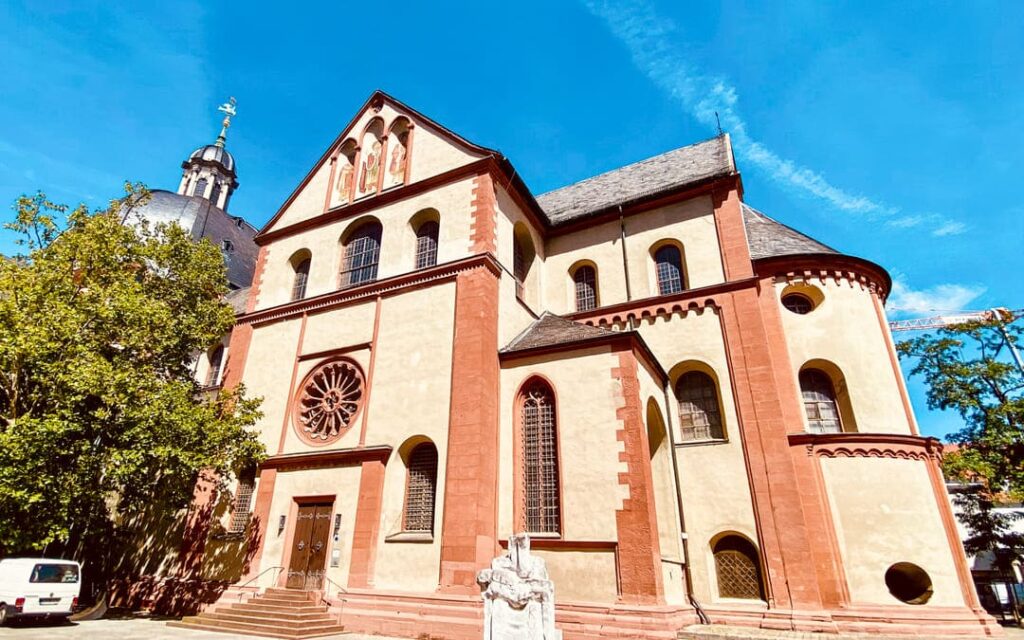
The Neumünster Church is one of the most important sights in Würzburg. It's located next to St. Kilian's Cathedral. The Neumünster was built at the place where the "Apostles of Franconia" Kilian, Kolonat and Totnan were martyred and died in 689. First, in the eighth century, Bishop Meningoz erected a memorial building (Salvator Cathedral) for the three murdered Irish itinerant preachers.
Around 1060 St. Adalbero founded the Neumünster Monastery. First a Romanesque basilica was built. The tower was added during the expansion in the 12th and 13th centuries. The baroque west building with the dome and the impressive west facade was built by Joseph Greissing at the beginning of the 18th century.
The sandstone Madonna in a pillar niche of the dome room is an early work by Tilman Riemenschneider.
In two buildings of the crypt of the Neumünster the coffins of St. Kilian and bishop Meningoz TranslatePress enables also the relics of the martyrs are kept. The urn tomb of Pastor Georg Häfner, who died in the Dachau concentration camp in 1942, is located in the crypt of St. Kilian's.
Neumünster Info
Address: Neumünster (access via main portal at Kürschnerhof)
Opening hours: daily 8 till 18:30
Admission: free
More info at Würzburg Tourist Information.
8. Lusamgärtlein (Lusam Garden)
Würzburg's most romantic sight is probably the cloister on the north side of the Neumünster, where there is a memorial stone to Walther von der Vogelweide (ca. 1170 to 1230). The minnesinger is said to have spent the last years of his life in the Neumünster monastery and to have been buried here in the Lusamgärtlein. The grave was probably removed when the Neumünster church was remodeled in the 18th century. In case of love sickness, it supposedly helps to put flowers on the memorial stone.
The still preserved romanesque cloister wing in the Lusamgärtlein is considered a major work of the Staufer period in Würzburg (built in the 12th century).

on the memorial stone for
Walther von der Vogelweide
Lusamgärtlein Info
Access Lusamgärtlein: from Martinstraße 4, 97070 Würzburg
Opening hours: freely accessible all day
More info at Würzburg Tourist Information.
9. Käppele (Capuchin Monastery Nikolausberg)

A Würzburg sight visible from afar is the baroque pilgrimage church on the Nicholas Hill (Nikolausberg), which is actually called "Visitation of the Virgin Mary".
The Nikolausberg already developed into a place of pilgrimage during the turmoil of the Thirty Years' War. A Franconian fisherman's son placed a carved vesper image in the vineyards around 1640. Soon, mainly winegrowers and farmers wandered up to the little Pietà. A first small chapel was built after some miraculous healings occurred.
Prince Bishop Johann Gottfried von Guttenberg agreed to the expansion of the chapel at the end of the 17th century after initial hesitation. When the decision was made in the middle of the 18th century to build a new chapel, court architect Balthasar Neumann - who would be surprised? - got the commission. The terraced path from the banks of the river Main to the Käppele is lined with 77 figures by Peter Wagner and 14 stations of the cross. Along the way, you can enjoy magnificent views over the city from the terraces.
As one of the few architectural monuments in Würzburg, the Käppele has been largely spared from the incendiary bombs of March 16, 1945.

Käppele Info
Address: Spittelbergweg 21, 97082 Würzburg
Opening hours: daily 8 till 17 o'clock
Admission: free
For further information, see Webiste of the Käppele.
10. Würzburg Stein - terroir f Würzburg
Already Goethe, Hermann Hesse, Leonhard Frank and Walther von der Vogelweide knew that wine has an inspiring effect. You will meet these poets at the terroir f Würzburg. From the literature balcony, which floats above Würzburg's best vineyard "Würzburg Stone" on the Stone-Wine-Trail, you can enjoy the magnificent view of the city, Marienberg Fortress and the vineyards, which rise from the Main valley. The viewing bridge is surrounded by 15 stelae, each showing one of the four literary figures, who all had a special relationship with Würzburg, depending on the angle of view and the direction of the compass. At the digital showcase you get more information about the topic wine and literature.
The Würzburg stone is the largest contiguous vineyard in Germany. On the 4 kilometer Stone-Wine-Trail you can take a nice walk through the vineyards. On the way 20 information boards inform you about the History of Franconian wine and Würzburg. Here you can find out interesting facts about the Stone-Wine Trail.
Würzburg Sights in the Surrounding Area (with Map)
There are some interesting destinations within a radius of about 30 km, for which you should plan two to three additional days.
For the beautiful boat trip to Veitshöchheim - which I would definitely recommend to do - you should plan a whole day.
In another day you can do Volkach (including terroir f, Vogelsburg and Maria im Weingarten), Prichsenstadt and possibly Iphofen. I did that, but found this day tour very exhausting (however, this was the hottest day in July with around 40°C). I would recommend you to split this into two day tours - for example Volkach and Prichsenstadt on one day, Iphofen, Marktbreit and Ochsenfurt on the other.
Recommended Destinations around Würzburg
The following destinations near Würzburg are worth seeing:
- Veitshöchheim (Tour of the castle and rococo garden!)
- terroir f Volkach
- Vogelsburg Castle (View of the Main Loop)
- Pilgrimage Church Maria im Weingarten (Mary in the Vineyard)
- Volkach old town
- Steigerwald:
- Prichsenstadt
- Iphofen
- Marktbreit
- Ochsenfurt
- Extra Tip: Rothenburg ob der Tauber: (60 km)
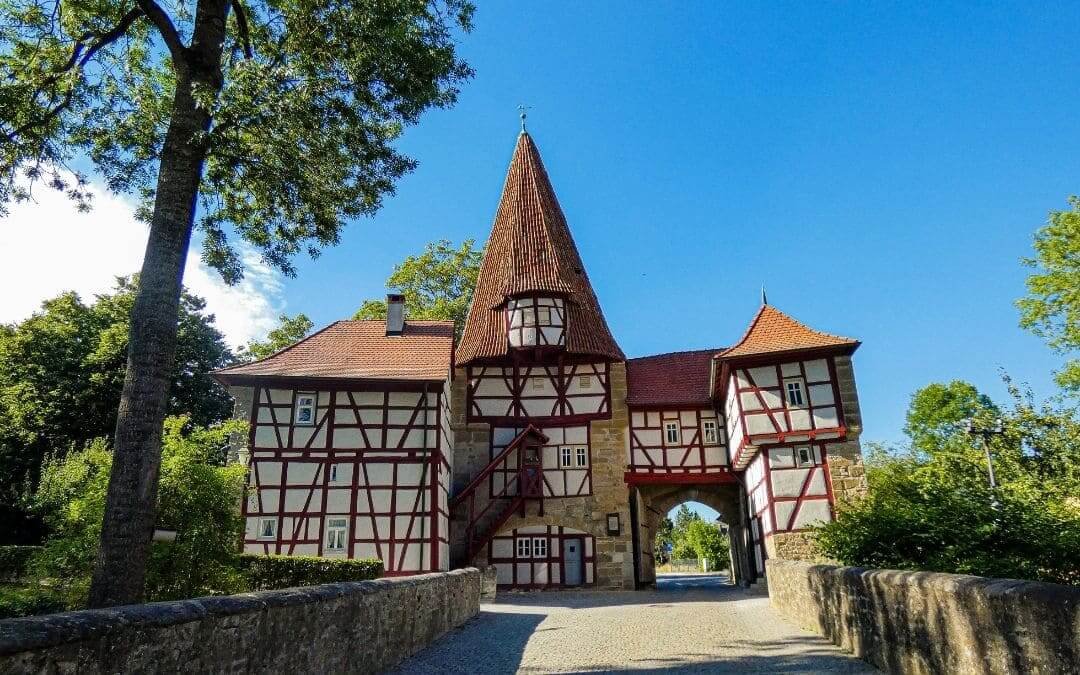
Wine, Art and Beautiful Views
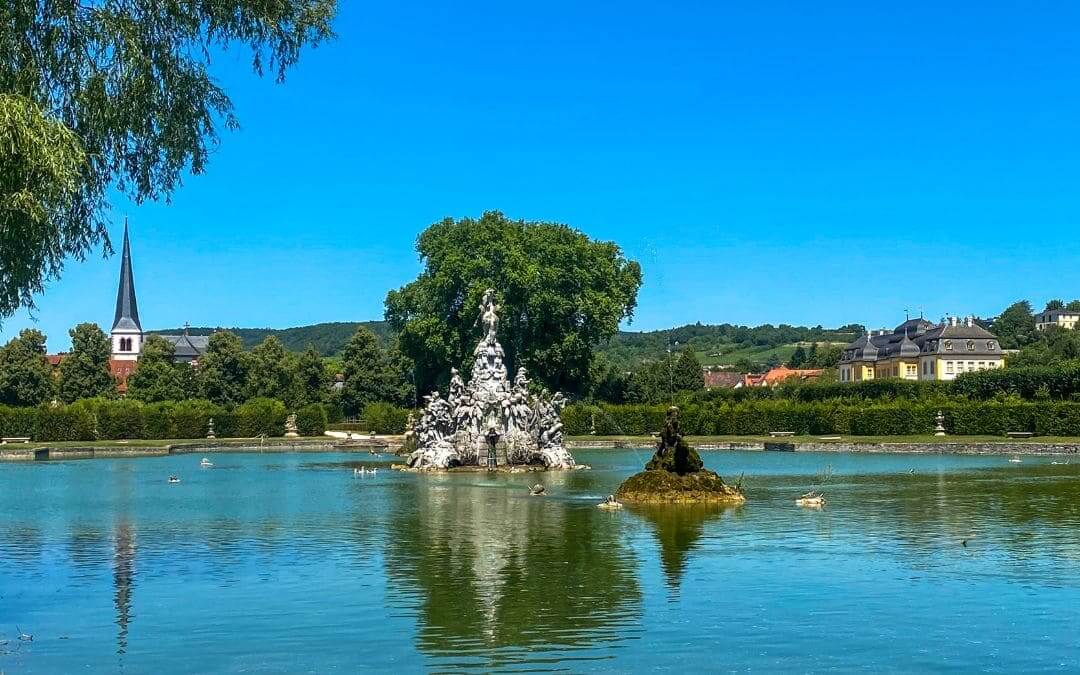
Don't miss to do a boat trip to Veitshöchheim. Veitshöchheim Castle was the summer residence of the Würzburg Prince-Bishops. The palace garden with arcades, lakes, fountains and about 300 sculptures is considered one of the most important rococo gardens in Europe.
A wine village worth seeing is Volkach which attracts visitors to a medieval village center, Riemenschneider art in Pilgrimage Church Maria im Weingarten (Mary in the Vineyard), as well as amazing views of the Mainschleife from the Vogelsburg Castle and the observation deck of the terroir f Volkach. Coming from Würzburg, you can visit one by one the terroir f, the Vogelsburg, the pilgrimage church and finally the old town of Volkach.
Picturesque Prichsenstadt with its cobblestone alleys, medieval half-timbered houses and the city wall with defense towers can be explored in about an hour along the "Historic City Tour". At the end you can stop at one of the cozy wine taverns.
You will find a couple of sights in Iphofen: Among others, there are the well-preserved medieval city fortifications with gates and towers, and the Rödelsee Gate, a landmark of Franconia.
Also Marktbreit, Birthplace of Alois Alzheimer (discoverer of the disease named after him), offers one of the most famous photo motifs in Franconia, painter angle (Malerwinkel).Take your time for a long walk.
Ochsenfurt, the largest town in the district of Würzburg, is located right at the river Main and offers almost completely preserved city fortifications with gates and towers, a well-known museum of traditional costumes, beautiful half-timbered houses and St. Andrew's parish church with a Santa Claus figure by Tilman Riemenschneider.
Last but not least is the medieval Rothenburg ob der Tauber: - one of the most popular destinations in Germany - only 60 km from Würzburg. If you haven't been to Rothenburg yet, it makes for a nice day trip.
Would you also like to get to know the surroundings of Würzburg?
In my detailed blog post Day Trips from Würzburg - the 11 Most Beautiful Destinations I show you highlights and Franconian wine villages around Würzburg.
The most important questions about your trip to Würzburg
Where exactly is Würzburg?
Würzburg is located in the north of the state of Bavaria, in the middle of the Franconian wine country. The city is located on the River Main and is easily accessible via the A3, A7 and A81 highways. It is approximately halfway between Frankfurt am Main and Nuremberg.
How big is Würzburg?
Würzburg has around 130,000 inhabitants, making it one of the medium-sized cities in Germany. The city covers an area of around 88 square kilometers.
Is Würzburg easy to explore on foot?
Yes, the old town of Würzburg is compact and many sights such as the Residenz, St. Kilian's Cathedral and the Old Main Bridge are close together. A city tour is therefore the ideal way to discover the city.
When is the best time to visit Würzburg?
The months of May to October are particularly recommended, as many wine festivals take place during this time and the mild weather invites you to take a walk and enjoy a "Brückenschoppen" on the Old Main Bridge.
What is a "Brückenschoppen"?
The term "Brückenschoppen" is used in Würzburg to describe the cozy get-together over a glass of Franconian wine on the Old Main Bridge. This custom is popular with locals and tourists alike and offers a wonderful atmosphere with a view of the Main and Marienberg Fortress.
Are there guided city tours in Würzburg?
Yes, the Tourist Information Würzburg offers regular guided tours, including themed tours on architecture, history or wine. Information on times and meeting points can be found on the official website of the city of Würzburg.
Which culinary specialties should you try in Würzburg?
Typical Franconian dishes such as "Schäufele" (pork shoulder with a crispy crust), "Blaue Zipfel" (fried sausages in vinegar) and regional wines such as Silvaner or Müller-Thurgau are particularly recommended. Traditional inns such as the "Backöfele" or the "Weinhaus Stachel" offer authentic Franconian cuisine.
Which museums are particularly worth visiting in Würzburg?
In addition to the Museum im Kulturspeicherwhich shows modern art, is the Martin von Wagner Museum with its collection of antiquities and picture gallery is well worth a visit. Also the Röntgen memorial sitewhich commemorates the discovery of X-rays by Wilhelm Conrad Röntgen, is interesting.
How do you get to Marienberg Fortress?
The Marienberg fortress can be reached on foot via a steep climb or comfortably by bus. The climb is rewarded with a magnificent view over the city.
Are there any recommended excursion destinations in the area around Würzburg?
Yes, the Franconian wine country offers numerous charming towns such as Volkach, Sommerach and Iphofen. The Romantic Road with towns such as Rothenburg ob der Tauber is also within easy reach. You can find out more about this in my article Day Trips from Würzburg - the 11 Most Beautiful Destinations.
Practical Würzburg Tips
To conclude my travel tips for Würzburg, I would like to give you some practical tips.
Tips for traveling to Würzburg
By plane:
Würzburg does not have its own airport. The nearest airports are:
The most convenient train connection is from the Rhine-Main Airport in Frankfurt. There is an hourly ICE direct connection to Würzburg. Travel time is about 90 minutes.
From both Nuremberg and Stuttgart airports, you first have to take the subway or S-Bahn from the airport to the main train station. From Nuremberg airport, travel time by train is an hour. And it takes a shocking 3 hours to get to Würzburg from Stuttgart airport.
By train:
The train station is located near the old town. If you come to Würzburg for a short stay only, it is a good option to arrive by train. The city has excellent connections to other major German cities.
By car:
Würzburg is conveniently located at the intersection of the A7 and A3 motorways, making it easily accessible by car from all directions. The electronic parking guidance system leads you to the parking lots and parking garages in the city center. However, keep in mind that the fees in the parking garages in the city center are high.
Parking in Würzburg
Unfortunately, as in most large cities, there is no free parking in Würzburg's city center. But there is a free large parking lot near the city center,which, thanks to a referendum in July 2022, will also remain free of charge (at least until further notice):
Talavera: There is a huge free parking lot here, unless there is an event like Kiliani or the Spring Festival (Frühjahrs-Volksfest). From here you can either walk to the city center in about 15 minutes or take the streetcar or bus from the Talavera stop This hardly saves any time, but you don't have to carry your luggage.
If you want to park closer to your (downtown) hotel, you will have to bite the bullet and park your car in a public garage, unless your hotel has its own parking spaces, but they will also charge. The cheapest parking garage in the city center is the Parking garage Theater with 16 € per day. For all other city center garages you have to pay 19 € to 24 € per day.
Get an overview of all parking spaces and rates you at WVV.
Planning a Self-Drive Tour in Germany?
Check out my article on the best road trip routes across the country you will find individual tour suggestions for your planning.
Tips on local transport in Würzburg
The sights of the city center are all within easy walking distance. But there is also a well-developed local transport network with buses and streetcars. The Day Ticket Solo for a single person is 4,50€, the Day Ticket Plus for two adults and their children/grandchildren under 15 years is 6,40€. A one-way ticket is available for 2,40€, a short-distance ticket (up to 4 stops after boarding) for 1,40€.
You can find all information about public transportation in Würzburg at WVV.
Stay overnight in Würzburg - right in the middle of wine, baroque and old town life
Würzburg is a city to stroll around, marvel at and enjoy. Whether it's the baroque Residenz, the imposing cathedral, the Old Main Bridge or the vineyards with a view of the Main Valley - many things are close together and can be explored on foot. If you live centrally, you can not only quickly reach the most important sights, but also experience the special flair of the city up close.
Here you will find three selected hotels for different budgets - all with style, a good location and plenty of Franconian hospitality.
💰 Fair: City Partner Hotel Strauss*
Located directly on the Juliuspromenade, this hotel is an ideal starting point for exploring the city on foot. The rooms are cozy, the breakfast is hearty and the hotel's restaurant serves Franconian classics. Price-conscious travelers are in good hands here.
⭐️ Comfortable: Hotel Würzburger Hof*
This traditional hotel with tastefully furnished rooms and a stylish breakfast area is just a few steps away from the Christmas market. After a wintry stroll through the festively decorated old town, you will find a quiet and comfortable place to relax and warm up.
👑 Luxurious: Steinburg Castle Hotel*
The elegant castle hotel is enthroned high above Würzburg amidst the vineyards of the "Würzburger Stein". Here you can enjoy stylishly furnished rooms, an excellent restaurant and a spa area with pool and sauna. The panoramic view over the city is the icing on the cake for an enjoyable weekend with that certain something.
Tips on Recommended Restaurants, Cafés and Beer Gardens in Würzburg
Restaurant und Weinhaus Zum Stachel:If you're in Würzburg, you should definitely treat yourself to an evening at the medieval Weinhaus Zum Stachel for the ambience alone! In the cozy courtyard, the delicious dishes with a creative touch and the Franconian wine taste twice as good! You should make a reservation here.
Address: Gressengasse 1, 97070 Würzburg; Phone: +49 931 527 70; click here to go to the website.
La Rustica: In a side alley behind the Hotel Alter Kranen I had a good meal at this "real" Italian restaurant. In summer, it's pleasant to sit at one of the tables on the sidewalk. Friendly service, medium price range.
Address: Karmelitenstraße 29, 97070 Würzburg; Phone: +49 931 4653 8811; click here to go to the website.
Locanda Würzburg: The riverside terrace of this Italian restaurant directly on the Alter Kranen is so popular in summer that I didn't manage to get a table without a reservation on my four evenings in Würzburg. The pizzas and pasta dishes on the diners' plates looked delicious. When the weather is nice, I don't think there is a better location in Würzburg.
Address: Kranenkai 1, 97070 Würzburg; Phone: +49 931 15600; click here to go to the website.
Beer garden Goldene Gans: A beautiful beer garden with friendly service in a prime location below the Marienberg Fortress. The view of the bridge, the river and the city is great, at least if you get a table on the Main side. Classic beer garden dishes (bratwurst with sauerkraut, natural sourdough bread or potato salad; snacks). I had pork neck steak with potato salad, accompanied by a glass of Franconian Silvaner. I liked it.
Address: Leonhard Frank Promenade, Burkarderstrasse 2 - 4, 97082 Würzburg; Phone (reservations from 6 people): +49 176 24476389; open seasonally, in good weather daily from 11 am. Click here to go to the website.
Wirtshaus Lämmle: Rustic Franconian restaurant with beer garden right next to the Lady's Chapel. On a still hot summer evening, I sat on the pleasantly airy terrace thanks to the old chestnut trees. I don't expect gourmet cuisine in a beer garden. The Obatzer accompanied by a Riesling was just the thing for me that evening after my sightseeing marathon.
Address: Marienplatz 5, 97070 Würzburg; Phone: +49 931 54 748; click here to go to the website.
Eiscafé Fontana: Twice, after dinner, I ended the day at the Vierröhrenbrunnen with an ice cream from Fontana. The selection of ice cream specialties from their own production leaves nothing to be desired. My choice: dark chocolate with tonka - to die for! And on warm summer evenings, the vibes are guaranteed to be good in this beautiful location.
Address: Beim Grafeneckart 8, 97070 Würzburg; Phone: +49 931 3292180; click here to go to the website.


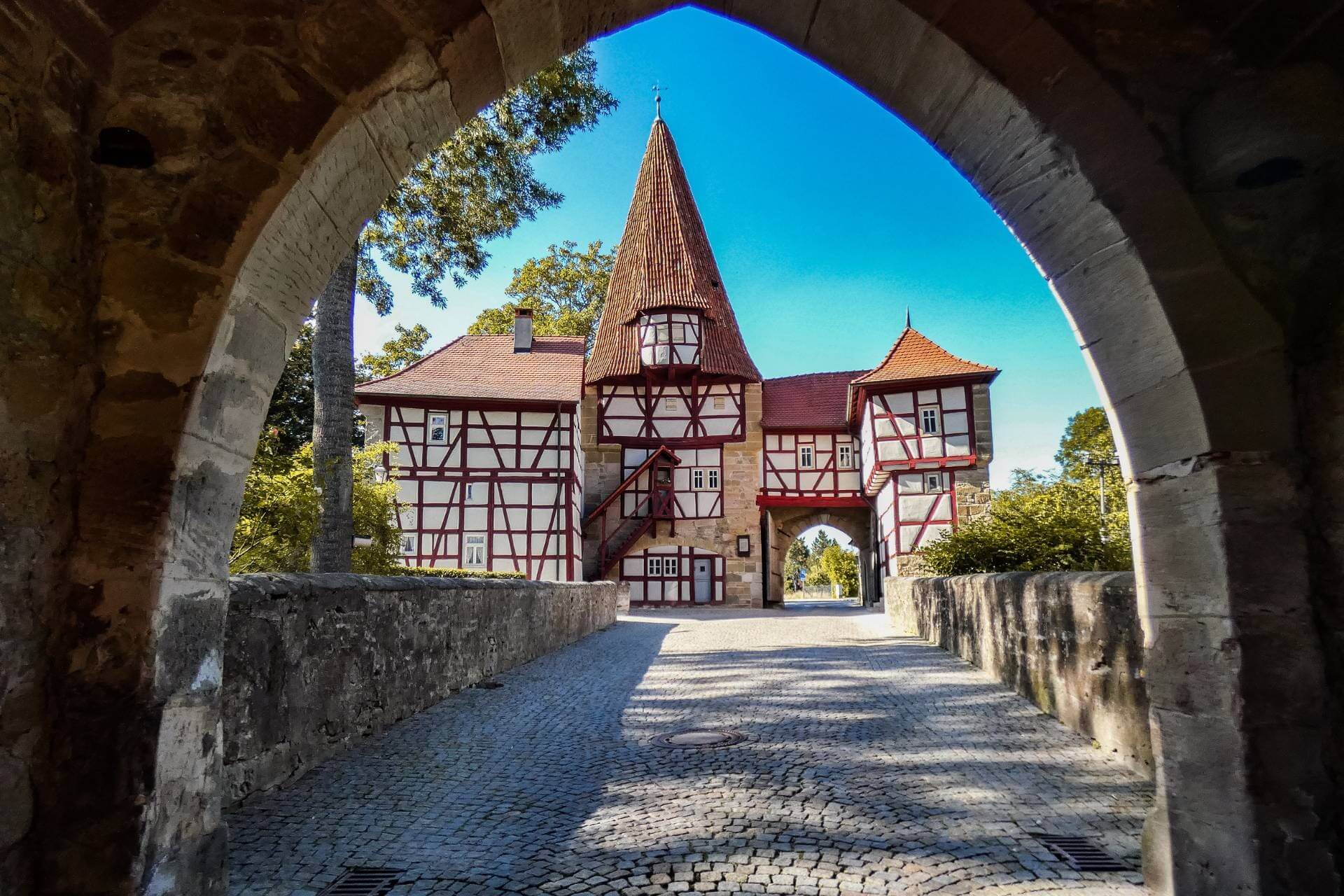

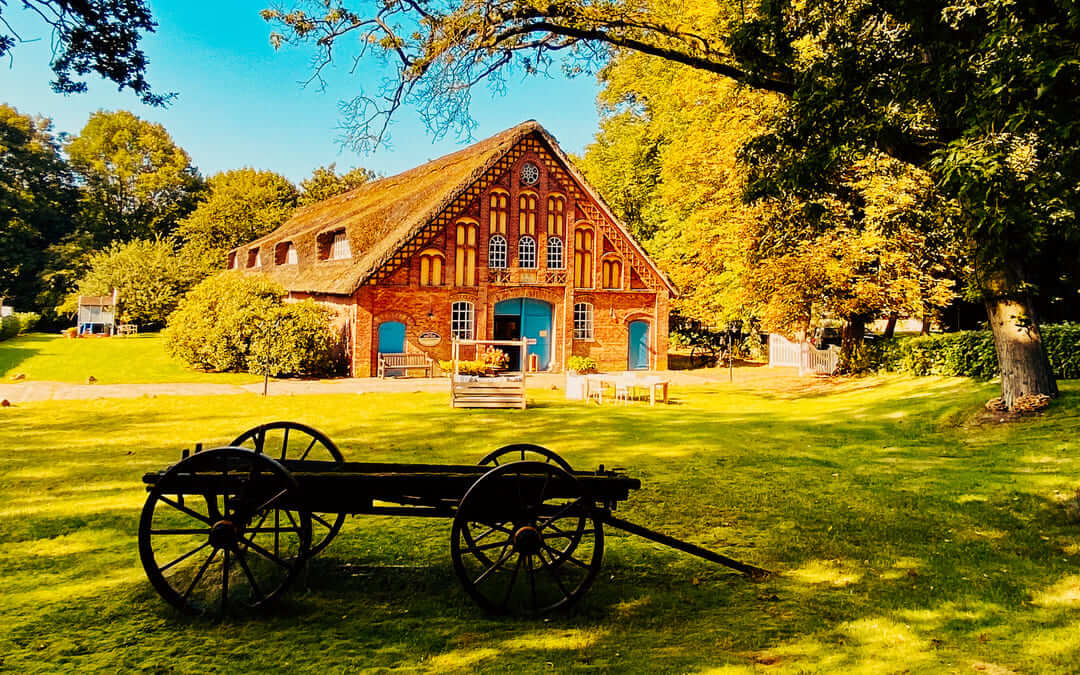


Würzburg offers so many impressive sights that you hardly know where to start. The Residence and the Old Main Bridge are an absolute must for every visitor. But also the Marienberg Fortress and the pilgrimage church Käppele should not be missing on any tour. And if you still have time, you should definitely visit the Botanical Garden of the University of Würzburg. This city is truly a jewel in Franconia!
Hello,
Thank you very much for the nice comment. Unfortunately, I didn't have the time for the Botanical Garden - there was just too much to see in beautiful Würzburg, but also outside. I'll definitely come back and see some of the things I missed on my first visit.
Many greetings,
Angelika
Dear Angelica,
I enjoyed your travel info. I am a Persian (Iranian) physicist and was attracted to nice Wurzburg because of the great German physicist Wilhelm Rontgen who invented the X-ray in 1896. My visit dream to Wurzburg was fulfilled last July. Another city attraction that you may add to your website could be the Rontgen Museum where he discovered the X-ray. This place is very close to the city Hauptbahnhof.
Best regards,
Ebrahim
Dear Ebrahim,
Thank you so much for your kind comment and the hint regarding Wilhelm Roentgen. I really wasn't aware that it was Wuerzburg where he discovered the X-ray. That's very interesting, and I will remember to include it in an update of the Wuerzburg blog post. I'm glad that you enjoyed your visit to Wuerzburg so much. I really was surprised about how much this beautiful city has to offer.
Take care!
Angelika
Great tips especially for accommodation and food.
Thank you so much, dear Nicole! I'm very happy that you find my tips helpful 🙂 I wish you a happy new year!
Hi Angelika,
that's quite a highlight. Thank you.
When the weather is better, we absolutely must look at and experience Würzburg and especially the proposed destinations in the area. Am particularly curious about the works of Tilmann Riemenschneider in Würzburg and Volkach plus Ochsenfurt, of which I knew nothing until now. Thanks also for the reference to Riemenschneider's support of the insurgents - today they would be called terrorists by the rulers.
We are eager to see the other suggestions for travel in our special country.
Dietmar
Hello Dietmar, thank you for your comment. You have already noticed that I was totally enthusiastic about Würzburg. The city and the area are definitely worth a visit. I was also surprised to learn that Tilman Riemenschneider and Götz von Berlichingen met in the Weinhaus Stachel. You learn stories like that on the guided city walks 🙂 Happy holidays and a happy new year!